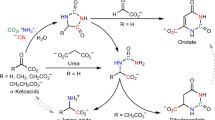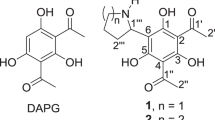Abstract
ALTHOUGH the utilization of asparagine and glutamine by micro-organisms has been studied in recent years, nothing is known about the metabolism of their simple peptides. Aspartic acid can support optimal growth of Leuconostoc mesen-teroides; but asparagine is utilized only to a small extent1,2. It has recently been found in this laboratory that the utilization of asparaginylglycine and glycylasparagine approximates that of the free di-carboxylic acid, and is better by far than that of asparagine2. The same was found to be true for Lactobacillus arabinosus under conditions of incubation that precluded the endogenous synthesis of aspartate (26° in vacuo over potassium hydroxide or 39°)3. On the other hand, glycylglutamine and glutaminylglycine replace glutamine molecule for molecule in the metabolism of L. arabinosus, and the organism grows in synthetic media containing the peptides or the free amide without the lag period characteristic of its growth in media containing glutamic acid. It has been shown previously that the sulphoxide derived from methionine competitively inhibits the utilization of glutamic acid, but has no effect on the utilization of glutamine4. In this respect, too, the glutamine peptides behave exactly as the free amide2.
This is a preview of subscription content, access via your institution
Access options
Subscribe to this journal
Receive 51 print issues and online access
$199.00 per year
only $3.90 per issue
Buy this article
- Purchase on Springer Link
- Instant access to full article PDF
Prices may be subject to local taxes which are calculated during checkout
Similar content being viewed by others
References
Hac, L. R., and Snell, E. E., J. Biol. Chem., 159, 291 (1945).
Miller, H. K., and Waelsch, H., Arch. Biochem. and Biophys. (in the press).
Borek, E., and Waelseh, H., J. Biol. Chem., 190, 191 (1950).
Waelsch, H., Owades, P., Miller, H. K., and Borek, E., J. Biol. Chem., 166, 273 (1946).
Melville, J., Biochem. J., 29, 179 (1935).
McIllwain, H., Roper, J. A., and Hughes, D. E., Biochem. J., 42, 492 (1948).
Owades, P., and Waelsch, H. (unpublished).
Author information
Authors and Affiliations
Rights and permissions
About this article
Cite this article
MILLER, H., WAELSCH, H. Utilization of Glutamine and Asparagine and their Peptides by Micro-organisms. Nature 169, 30–31 (1952). https://doi.org/10.1038/169030a0
Issue Date:
DOI: https://doi.org/10.1038/169030a0
Comments
By submitting a comment you agree to abide by our Terms and Community Guidelines. If you find something abusive or that does not comply with our terms or guidelines please flag it as inappropriate.



